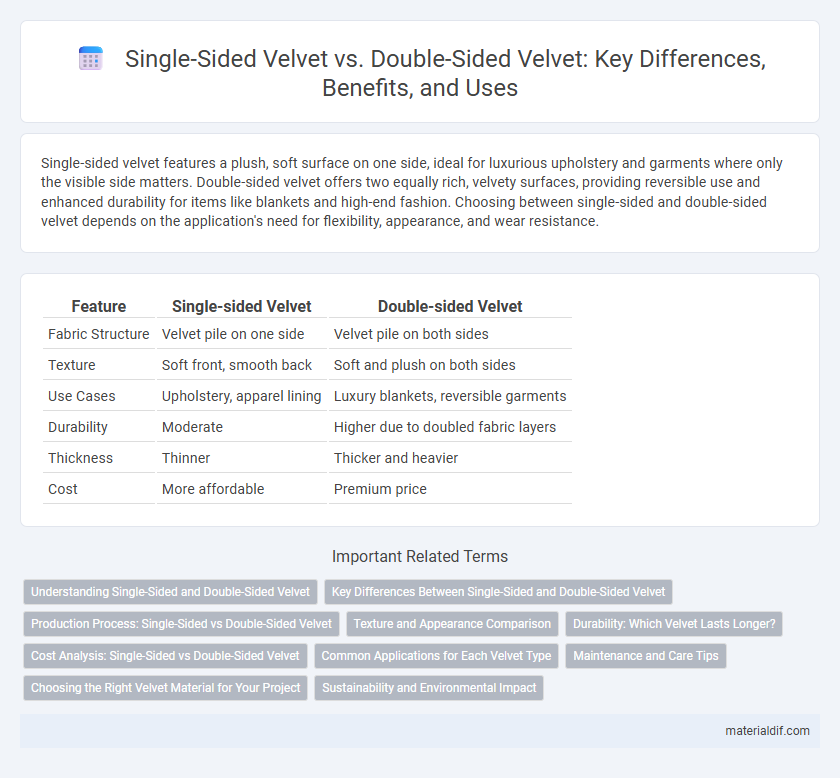Single-sided velvet features a plush, soft surface on one side, ideal for luxurious upholstery and garments where only the visible side matters. Double-sided velvet offers two equally rich, velvety surfaces, providing reversible use and enhanced durability for items like blankets and high-end fashion. Choosing between single-sided and double-sided velvet depends on the application's need for flexibility, appearance, and wear resistance.
Table of Comparison
| Feature | Single-sided Velvet | Double-sided Velvet |
|---|---|---|
| Fabric Structure | Velvet pile on one side | Velvet pile on both sides |
| Texture | Soft front, smooth back | Soft and plush on both sides |
| Use Cases | Upholstery, apparel lining | Luxury blankets, reversible garments |
| Durability | Moderate | Higher due to doubled fabric layers |
| Thickness | Thinner | Thicker and heavier |
| Cost | More affordable | Premium price |
Understanding Single-Sided and Double-Sided Velvet
Single-sided velvet features a plush, soft pile on one side with a smooth backing, making it ideal for upholstery and apparel where only one surface is visible. Double-sided velvet offers rich, luxurious texture on both sides, enhancing its versatility for reversible garments, home decor, and accessories. Choosing between single-sided and double-sided velvet depends on the desired aesthetic, durability, and application requirements.
Key Differences Between Single-Sided and Double-Sided Velvet
Single-sided velvet features a plush, textured pile on one side with a smooth backing, making it ideal for upholstery where only the front is visible. Double-sided velvet has soft, dense piles on both sides, offering reversible use and enhanced durability suitable for garments and reversible upholstery. The key differences include texture presence, application versatility, and cost, with double-sided velvet generally being thicker and more expensive due to its dual-surface construction.
Production Process: Single-Sided vs Double-Sided Velvet
Single-sided velvet is produced by weaving a pile on one side of the fabric, creating a plush texture only on the front while the back remains flat and smooth. Double-sided velvet involves weaving two layers of fabric simultaneously, with piles on both sides linked at the base, resulting in a thicker, reversible material. The production process of double-sided velvet is more complex and time-consuming, requiring precise control to maintain uniform pile height and density on both faces.
Texture and Appearance Comparison
Single-sided velvet features a plush, soft pile on one side with a smooth backing, creating a luxurious texture with a distinct front surface, while double-sided velvet boasts pile on both sides, offering a more uniform softness and reversible appearance. The texture of single-sided velvet feels more structured and defined, whereas double-sided velvet provides a plush, cushioned handfeel on either side. Visually, single-sided velvet displays a rich, vibrant surface contrasted by a matte underside, while double-sided velvet presents a consistent sheen and color on both faces, enhancing its versatility in design applications.
Durability: Which Velvet Lasts Longer?
Double-sided velvet typically offers greater durability compared to single-sided velvet due to its construction with pile fabric on both sides, reducing wear and tear from frequent use. Single-sided velvet, with plush fibers only on one side and a backing fabric on the other, can wear down more quickly under heavy use as the backing is less resistant to abrasion. Fabrics with a higher density pile and double-sided weaving maintain their texture and appearance longer, making double-sided velvet the preferred choice for upholstery and high-traffic applications.
Cost Analysis: Single-Sided vs Double-Sided Velvet
Single-sided velvet typically costs less than double-sided velvet due to its simpler manufacturing process, requiring fabric to be woven or embossed on only one side. Double-sided velvet, offering a luxurious feel on both sides, demands more advanced production techniques and higher-quality materials, resulting in increased expenses. Businesses and consumers weigh these cost differences against the intended application and durability requirements to optimize budget and aesthetic appeal.
Common Applications for Each Velvet Type
Single-sided velvet is commonly used in apparel, upholstery, and soft furnishings where the plush texture is visible on one side, such as dresses, cushions, and curtains. Double-sided velvet finds applications in luxury clothing, drapery, and upholstery, offering a soft, rich feel on both sides ideal for reversible garments and high-end home decor. Both types serve the fashion and interior design industries but are selected based on the desired tactile experience and visual appeal.
Maintenance and Care Tips
Single-sided velvet requires careful handling to avoid crushing its pile, using gentle brushing and spot cleaning to maintain its texture, while double-sided velvet offers added durability with pile on both sides, which can handle more frequent use and cleaning. For maintaining single-sided velvet, vacuuming with a soft brush attachment and avoiding direct sunlight preserves the fabric's lustrous appearance. Double-sided velvet benefits from regular rotation of use and professional cleaning to sustain its plush feel and prevent wear on both velvet surfaces.
Choosing the Right Velvet Material for Your Project
Single-sided velvet features a plush pile on one side and a flat backing, ideal for upholstery or projects where only one visible side is needed, offering affordability and ease of handling. Double-sided velvet boasts a soft pile on both sides, providing a luxurious appearance and greater durability, perfect for reversible garments or items requiring a high-end finish. Selecting between single-sided and double-sided velvet depends on the project's aesthetic requirements, budget constraints, and desired functionality for optimal results.
Sustainability and Environmental Impact
Single-sided velvet typically requires less water and energy during manufacturing, resulting in a smaller carbon footprint compared to double-sided velvet, which involves extra processing to finish both sides. The production of double-sided velvet often leads to higher fabric waste and increased chemical usage, intensifying its environmental impact. Choosing single-sided velvet supports sustainability by minimizing resource consumption and reducing pollution in the textile industry.
Single-sided Velvet vs Double-sided Velvet Infographic

 materialdif.com
materialdif.com